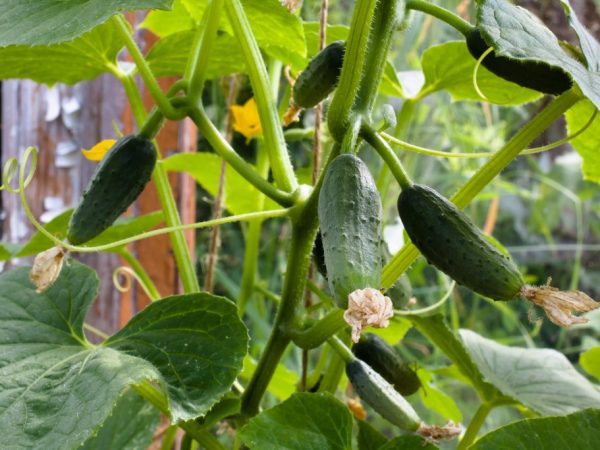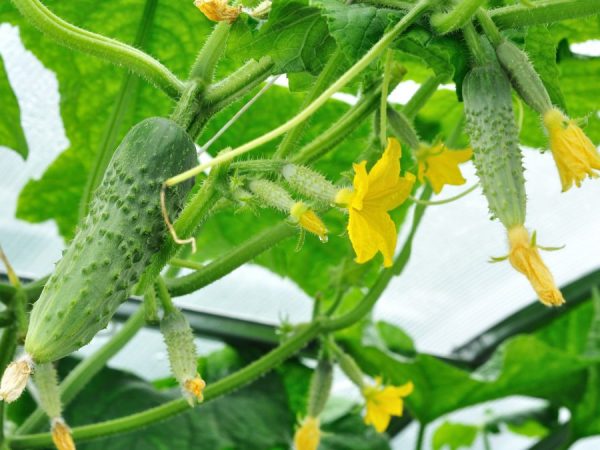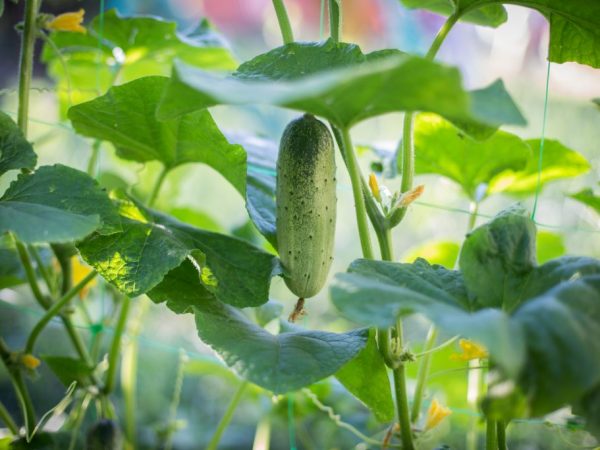The best varieties of cucumbers with the letter K
By growing vegetables, every farmer wants to get the most out of the plant. Thanks to long-term breeding work, there are many seeds on the domestic market that meet the needs of gardeners. What are the best varieties of cucumbers starting with the letter K? Let's take a closer look at proven and productive hybrids.

The best varieties of cucumbers with the letter K
Early species
The climatic features of the region do not always allow the cultivation of late varieties. To get a lot of delicious cucumbers in a short time, you need to find the right variety.
Casper
A strong and undemanding plant, its characteristics resemble the popular Cappuccino and Cornet. It independently copes with pollination, therefore it is suitable for closed structures. From the appearance of the first shoots to the harvest, 40 days pass. A culture with bunched laying of ovaries forms from 4 to 8 fruits in the axils. At the genetic level, the bush has a strong immunity to fungi.
The Kasper hybrid will delight gardeners with abundant cucumber yields for a long time. Subject to the minimum care requirements, at least 17 kg are removed from a square meter of plantings. Short identical greens are covered with huge tubercles and white thorns. The absence of bitterness and a wonderful aroma allows you to use the product in any form.
Cassandra
An early productive plant will delight with the first fruits already 43 days after germination. Specialized for development under plastic shelters, so no additional pollinators are needed. The bushes are not afraid of powdery mildew and the cucumber mosaic virus.
Cassandra F1 refers to hybrids with a bundle type of ovary setting. Neat fruits grow up to 15 cm in length and up to 120 g in weight. At the genetic level, they are devoid of bitterness. There are no seed voids in the pulp. Fruits will perfectly show taste characteristics in salads and pickles.
Spring whim
If you are looking for early cucumbers, then we advise you to pay attention to the presented hybrid. In the period of fruiting, the plant enters 42 days after pecking from seeds. Powerful, vigorous bushes are not afraid of powdery mildew and temperature fluctuations.
Cucumbers Caprice spring F1 reach a length of 20 cm, with a weight of about 150 grams. The sweetish taste without bitterness will perfectly open in salads and slices. At least 13 kilograms of zelents are removed from one square meter of plantings.
Little son
A popular early variety that enters the yield period 6 weeks after hatching from seed. According to the description, it resembles a little cucumbers Kapelka, Kukolka and Dwarf: the bushes are intended for outdoor cultivation, although they bear fruit well in a winter greenhouse. The high degree of parthenocarp makes it possible to develop without the participation of pollinators. The hybrid is genetically resistant to the following diseases:
- mosaic virus;
- root rot;
- powdery mildew;
- cladosporiosis.
Baby F1 son is neat cylindrical fruits weighing 90 grams. The thin green peel is covered with light longitudinal stripes and small tubercles. Excellent taste and market characteristics are preserved for a long time. With minimal care, it is possible to remove from 10 kg of zelents from one square.
Kafkas

Suitable for greenhouse cultivation
An early salad species begins to bear fruit on the fortieth day after pecking from seeds. A weakly branched bush of a female flowering type is not afraid of common ailments. Specialized for growing under polyethylene structures.
The Kafkas variety has aromatic fruits that grow in weight up to 150 grams. Thin skin and tasty pulp make the product an excellent option for fresh consumption. Remove about 25 kg from one square.
Kuzya
The hybrid, undemanding to care, will appeal to novice farmers. The pantenocarp plant is suitable for growing in any type of soil. A compact bush, like the Krasavchik Hikmet variety, is easy to place on a windowsill or veranda.
Possesses increased resistance to powdery mildew, cucumber mosaic virus.
Cucumber Kuzya F1 in its characteristics resembles the popular cultivar Kucha Mala. The fruits do not taste bitter, which makes them an excellent option for pickling and pickling. Zelentsy are harvested at the stage of gherkins and even pickles. Small, cylindrical fruits easily tolerate long-term storage and transportation.
King
In domestic trading networks, there are two varieties of the variety, which have minor differences. If the King of the market variety is a plant of a bouquet-like type of ovary, then the hybrid King of the Garden refers to ordinary vegetables. Otherwise, the characteristics of the vines are the same.
Early cucumbers will delight the farmer 42 days after the mass pecking of seedlings. Tasty, flavorful fruits are genetically devoid of bitterness, so they will be equally good in salads and pickles. With long-term storage and transportation, they do not lose their commercial characteristics.
Caucasus
A plant that is specialized for indoor cultivation. A medium-sized bush is not afraid of common species ailments. The variety retains fruiting in conditions of reduced light intensity and at low temperatures. Suitable for year-round cultivation in greenhouses. Like the Katya variety, it is suitable for planting before winter.
Kavkaz F1 is a fruitful hybrid, therefore, it is possible to remove from 20 to 45 kg from each square. Smooth, glossy skin covers long greens. The variety is characterized by a pleasant dense pulp without specific bitterness and without empty chambers.
Mid-early species
Unlike early cucumbers, these varieties stand out for their high taste characteristics and good keeping quality. A huge number of hybrids are presented in domestic retail chains, but it is better to choose proven varieties.
Cannon
If you are looking for seeds for industrial cultivation, we recommend that you pay attention to a plant of mixed flowering. A mid-ripening vine will delight gardeners 8.5 weeks after sprouting. The bee-pollinated bush develops without problems in low light conditions and is not afraid of rot, mosaic and ascochitosis. If pollinating varieties are planted nearby, then the hybrid can be cultivated in a greenhouse.
In terms of taste and appearance, Carambol F1 resembles the Karina variety, beloved by domestic farmers. Large, elongated fruits weigh up to 200 grams. Delicious greens are intended for salad use. The products retain their commercial characteristics for a long time, they can be transported without problems.
Karelian plus

The plant will delight you with productivity
The self-pollinated variety Karelsky Plus is not afraid of low temperatures and has good resistance to cucumber diseases.It enters the yield period at the sixth week after germination, and can develop without problems on poor soils. Simultaneously and abundantly bears fruit until the first frost.
Usually at least 10 kg are removed from one plant. Outwardly, the greens resemble a spindle, the length of which reaches 9 cm. Due to the pleasant aroma and lack of bitterness, the products are most often used for processing.
Cadet
The shade-tolerant variety develops excellently both on the street and in the greenhouse. Tall bushes with a powerful root system are resistant to cucumber diseases. The mid-ripening variety begins to bear fruit in the eighth week after sprouting.
The Cadet hybrid has tasty, large greens, reaching a length of 21 cm. Small tubercles densely cover the bright skin. Due to its pleasant aroma and long-term storage, the products are popular with domestic gardeners.
Cruise
A plant of Russian selection will delight you with a harvest 50 days after hatching from seeds. It develops well in open ground and greenhouses. The bush is resistant to typical diseases and is not afraid of heat.
Cucumbers Cruise F1, like the Kolyan and Karapuz varieties, are classified as gherkin-type hybrids. Small greens are covered with a peel with large tubercles. Neat and fragrant fruits are suitable for pickling and pickling.
Import selection
Foreign hybrids Corinna and Kozyrnaya Karta have long been favorites among our farmers. But the price is not always affordable, so you have to look for more budget options. Let's analyze the most suitable species for domestic farmers.
Corentin
The Dutch plant will delight you with the first harvest 6 weeks after germination. An undemanding variety is grown in any type of soil. The bush is not afraid of common ailments, so it will grow with novice agrarians without problems.
The beautiful, uniform fruits of the Corentin hybrid are very similar to the domestic cucumbers Quadrille and Carolina. The products have excellent marketability and taste, and lie for a long time without noticeable losses in appearance. Universal use of zelents, which perfectly reveal the aroma in salads and pickles.
Capricorn
The Turkish variety will delight you with early fruiting. It can be grown without problems in any type of soil. You don't need bees and pollinating plants to get a bountiful harvest. All positive characteristics are manifested only in warmth, therefore, lowering the earth temperature below 15 degrees is not recommended.
The Capricorn hybrid has beautiful neat fruits, reaching a length of 14 cm. It is versatile in use, although the rich pulp will best show its characteristics when fresh. The main crop is harvested after the first ripening.
Krak
A popular cucumber of Polish selection belongs to a bee-pollinated variety of vegetables, in terms of characteristics it is a bit like the domestic Krepysh. A mid-early plant will delight with the first harvest 8 weeks after the mass emergence of shoots. The culture is very demanding on soil fertility, heat and moisture, however, it will forgive gardeners for mistakes in growing technology.
The fruits of the Krak hybrid do not turn yellow and do not outgrow, the average length reaches 11 cm. The products are devoid of specific bitterness. There is a lot of sugar in the pulp, so greens can be salted and pickled.
Componist
The cucumber bred by Dutch breeders is used to obtain gherkins. The bush, undemanding to care, is not afraid of species diseases, reveals its potential in greenhouses and on the street. With increasing illumination, five ovaries can be formed at the nodes.
Componist F1 will delight farmers with small fruits of the same shape. The products are genetically free from bitterness and have an excellent taste. It is not afraid of long-term transportation and stands out for its high keeping quality.
Conclusion
When choosing cucumber seeds for seedlings, the gardener wants to get a bountiful harvest with minimal financial investment.It is difficult to find a suitable one among the assortment of hybrids. We hope that our recommendations will help you in your choice.


